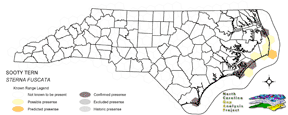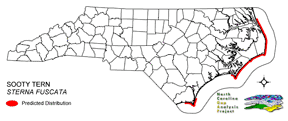
| Taxa: |
| Order: |
| Family: |
| Aves |
| Charadriiformes |
| Laridae |
| NatureServe Global Rank: |
| NatureServe State (NC) Rank: |
| G5 |
| S1B,S3N |
| Federal Status: |
| NC State Status: |
| --- |
| --- |


| Land Unit |
| US Fish & Wildlife Service |
| US Forest Service |
| US National Park Service |
| US Department of Defense |
| NC State Parks |
| NC University System |
| NC Wildlife Res. Com. |
| NC Forest Service |
| NC Div. of Coastal Mgmt. |
| Local Governments |
| Non-Governmental Org. |
| Other Public Lands |
| Private Lands |
| GAP Status 1-2 |
| All Protected Lands |
| Statewide |
| Hectares |
| 376.83 |
| 0.00 |
| 9.63 |
| 3,934.53 |
| 184.95 |
| 0.00 |
| 0.00 |
| 0.00 |
| 33.75 |
| 0.00 |
| 0.00 |
| 0.00 |
| 2,435.13 |
| 2,241.36 |
| 4,539.69 |
| 6,974.82 |
| Acres |
| 931.17 |
| 0.00 |
| 23.80 |
| 9,722.43 |
| 457.02 |
| 0.00 |
| 0.00 |
| 0.00 |
| 83.40 |
| 0.00 |
| 0.00 |
| 0.00 |
| 6,017.34 |
| 5,538.52 |
| 11,217.82 |
| 17,235.15 |
| % of Dist. on |
| Prot. Lands |
| 8.3 % |
| 0.0 % |
| 0.2 % |
| 86.7 % |
| 4.1 % |
| 0.0 % |
| 0.0 % |
| 0.0 % |
| 0.7 % |
| 0.0 % |
| 0.0 % |
| 0.0 % |
| 0.0 % |
| 49.4 % |
| ----- |
| ----- |
| % of Dist. on |
| All Lands |
| 5.4 % |
| 0.0 % |
| 0.1 % |
| 56.4 % |
| 2.7 % |
| 0.0 % |
| 0.0 % |
| 0.0 % |
| 0.5 % |
| 0.0 % |
| 0.0 % |
| 0.0 % |
| 34.9 % |
| 32.1 % |
| ----- |
| ----- |
|
Occasionally seen at tern colonies but has never nested successfully (Fussell 1994). Spends most of the year at sea, where it snatches food from the surface of the ocean without diving or sitting on water (Ehrlich et al. 1988). Nests in large colonies on sandy island beaches (Kaufman 1996). Eggs are laid among sparse grasses on bare sand or in a simple nest on the sand (Ehrlich et al. 1988). NATURE SERVE GLOBAL HABITAT COMMENTS: NON-BREEDING: primarily pelagic. Nests usually on remote outlying islets and rocks; on sandy beaches, bare ground or coral, most often with scattered grasses present or among bushes (under dense vegetation at Culebra, Puerto Rico), less frequently on rocky ledges; see Spendelow and Patton (1988) for further details on nesting sites in different areas. Young seek shade when not being brooded. |
| Code | Name | Description | NC Natural Heritage Program Equivalent |
| 378 | Ocean Beaches | Open beach sand. | Upper Beach |
| 371 | Maritime Grasslands | Dune grass community consisting of sea oats and beach grasses. | Dune grass, Maritime dry grassland |
| 8 | Open water | Open water without aquatic vegetation. | No equivalent |
|
Kepler, C. B. 1978. The breeding ecology of sea birds on Monito Island, Puerto Rico. Condor 80:72-87.
Fairbairn, P., and A. Haynes. 1982. Jamaican surveys of the West Indian manatee TRICHECHUS MANATUS, dolphin TURSIOPS TRUNCATUS, sea turtles (families Cheloniidae and Dermochelydae) and booby terns (family Laridae). FAO Fish. Rep. 278:289-295. Bent, A.C. 1921. Life histories of North American gulls and terns. U.S. Natl. Mux. Bull. 113. Washington, D.C. Fussell, J.O. III. 1994. A birderís guide to coastal North Carolina. Chapel Hill and London: The University of North Carolina Press. Kaufman K. 1996. Lives of North American Birds. Boston, New York: Houghton Mifflin Company. Clapp, R. B., and P. A. Buckley. 1984. Status and conservation of seabirds in the southeastern United States. Pages 135-155 in Croxall et al., eds. Status and conservation of the world's seabirds. ICBP Tech. Pub. No. 2. Cooper, J., A. J. Williams, and P. L. Britton. 1984. Distribution, population sizes and conservation of breeding seabirds in the Afrotropical region. Pages 403-419 in Croxall et al., eds. Status and conservation of the world's seabirds. ICBP Tech. Pub. No Coulter, M. C. 1984. Seabird conservation in the Galapagos Islands, Ecuador. Pages 237-44 in Croxall et al. (editors). Status and Conservation of the World's Seabirds. International Council for Bird Preservation Technical Publication. No. 2. de Korte, J. 1984. Status and conservation of seabird colonies in Indonesia. Pages 527-545 in Croxall et al., eds. Status and conservation of the world's seabirds. ICBP Tech. Pub. No. 2. Feare, C. J. 1984. Seabird status and conservation in the tropical Indian Ocean. Pages 457-471 in Croxall et al., eds. Status and conservation of the world's seabirds. ICBP Tech. Pub. No. 2. Gallagher, M. D., et al. 1984. The distribution and conservation of seabirds breeding on the coasts and islands of Iran and Arabia. Pages 421-456 in Croxall et al., eds. Status and conservation of the world's seabirds. ICBP Tech. Pub. No. 2. Garnett, M. C. 1984. Conservation of seabirds in the South Pacific region:a review. Pages 547-558 in Croxall et al., eds. Status and conservation of the world's seabirds. ICBP Tech. Pub. No. 2. Harrison, C.S., M.B. Naughton, and S.I. Fefer. 1984. The status and conservation of seabirds in the Hawaiian Archipelago and Johnston Atoll. Pages 513-526 in Croxall et al., eds. Status and conservation of the world's seabirds. ICBP Tech. Pub. No. 2. Hasegawa, H. 1984. Status and conservation of seabirds in Japan, with special attention to the short-tailed albatross. Pages 487-500 in Croxall et al., eds. Status and conservation of the world's seabirds. ICBP Tech. Pub. No. 2. Melville, D. S. 1984. Seabirds of China and the surrounding seas. Pages 501-511 in Croxall et al., eds. Status and conservation of the world's seabirds. ICBP Tech. Pub. No. 2. Robertson, C. J. R., and B. D. Bell. 1984. Seabird status and conservation in the New Zealand region. Pages 573-586 in Croxall et al., eds. Status and conservation of the world's seabirds. ICBP Tech. Pub. No. 2. Harrison, C. 1978. A field guide to the nests, eggs and nestlings of North American birds. Collins, Cleveland, Ohio. Schlatter, R. P. 1984. The status and conservation of seabirds in Chile. Pages 261-269 in Croxall et al., eds. Status and conservation of the world's seabirds. ICBP Tech. Publ. No. 2. Sprunt, A., IV. 1984. The status and conservation of seabirds of the Bahama Islands. Pages 157-168 in Croxall et al., eds. Status and conservation of the world's seabirds. ICBP Tech. Pub. No. 2. van Halewyn, R., and R. L. Norton. 1984. The status and conservation of seabirds in the Caribbean. Pages 169-222 in Croxall et al., eds. Status and conservation of the world's seabirds. ICBP Tech. Pub. No. 2. van Tets, G. F., and P. J. Fullagar. 1984. Status of seabirds breeding in Australia. Pages 559-571 in Croxall et al., eds. Status and conservation of the world's seabirds. ICBP Tech. Pub. No. 2. Williams, A. J. 1984. Breeding distribution, numbers and conservation of tropical seabirds on oceanic islands in the South Atlantic Ocean. Pages 393-401 in Croxall et al., eds. Status and conservation of the world's seabirds. ICBP Tech. Pub. No. 2. Terres, J.K. 1980. The Audubon Society encyclopedia of North American birds. Alfred A. Knopf, New York. Berger, A.J. 1981. Hawaiian Birdlife. Second Edition. University of Hawaii Press, Honolulu, Hawaii. xv + 260 pp. American Ornithologists' Union (AOU), Committee on Classification and Nomenclature. 1983. Check-list of North American Birds. Sixth Edition. American Ornithologists' Union, Allen Press, Inc., Lawrence, Kansas. Raffaele, H.A. 1983. A guide to the birds of Puerto Rico and the Virgin Islands. Fondo Educativo Interamericano, San Juan, Puerto Rico. 255 pp. Haynes, A. 1987. Human exploitation of seabirds in Jamaica. Biol. Conserv. 41:99-124. Pratt, H.D., P.L. Bruner, and D.G. Berrett. 1987. A field guide to the birds of Hawaii and the tropical Pacific. Princeton University Press, Princeton, New Jersey. 409 pp. + 45 plates. Ehrlich, P.R., D.S. Dobkin, and D. Wheye. 1988. The birder's handbook:a field guide to the natural history of North American birds. Simon and Shuster, Inc., New York. xxx + 785 pp. Spendelow, J.A., and S.R. Patton. 1988. National atlas of coastal waterbird colonies in the contiguous United States:1976-1982. U.S. Fish and Wildlife Service, Biological Report 88(5). x + 326 pp. Stiles, F.G., and A.F. Skutch. 1989. A guide to the birds of Costa Rica. Comstock Publ. Associates, Cornell University Press, Ithaca, New York. 511 pp. |
For more information please contact them at:
NC-GAP Analysis Project
Dept. of Zoology, NCSU
Campus Box 7617
Raleigh, NC 27695-7617
(919) 513-2853
www.basic.ncsu.edu/ncgap